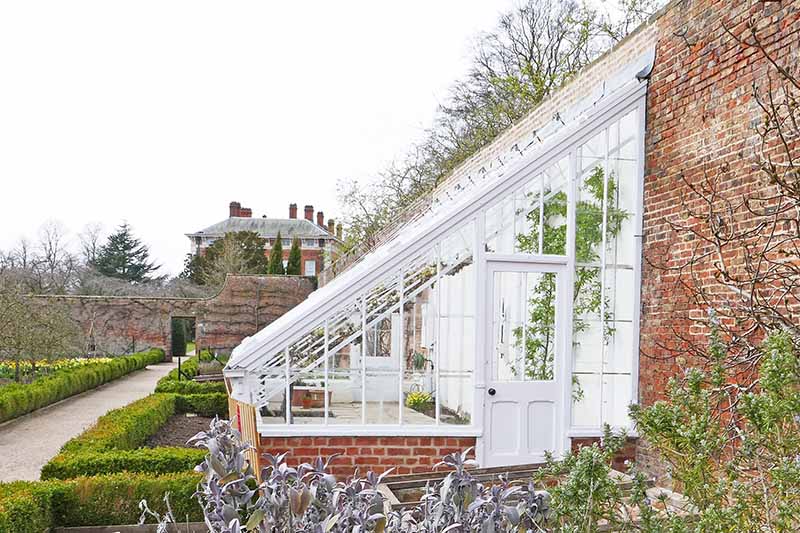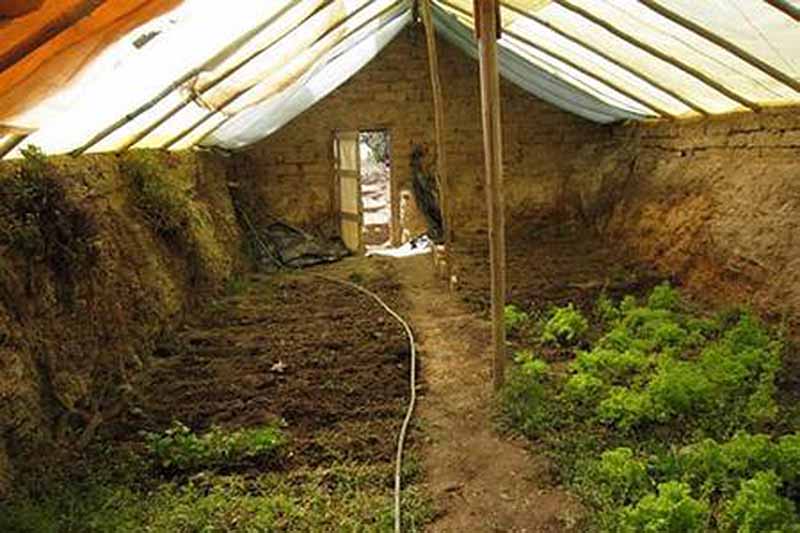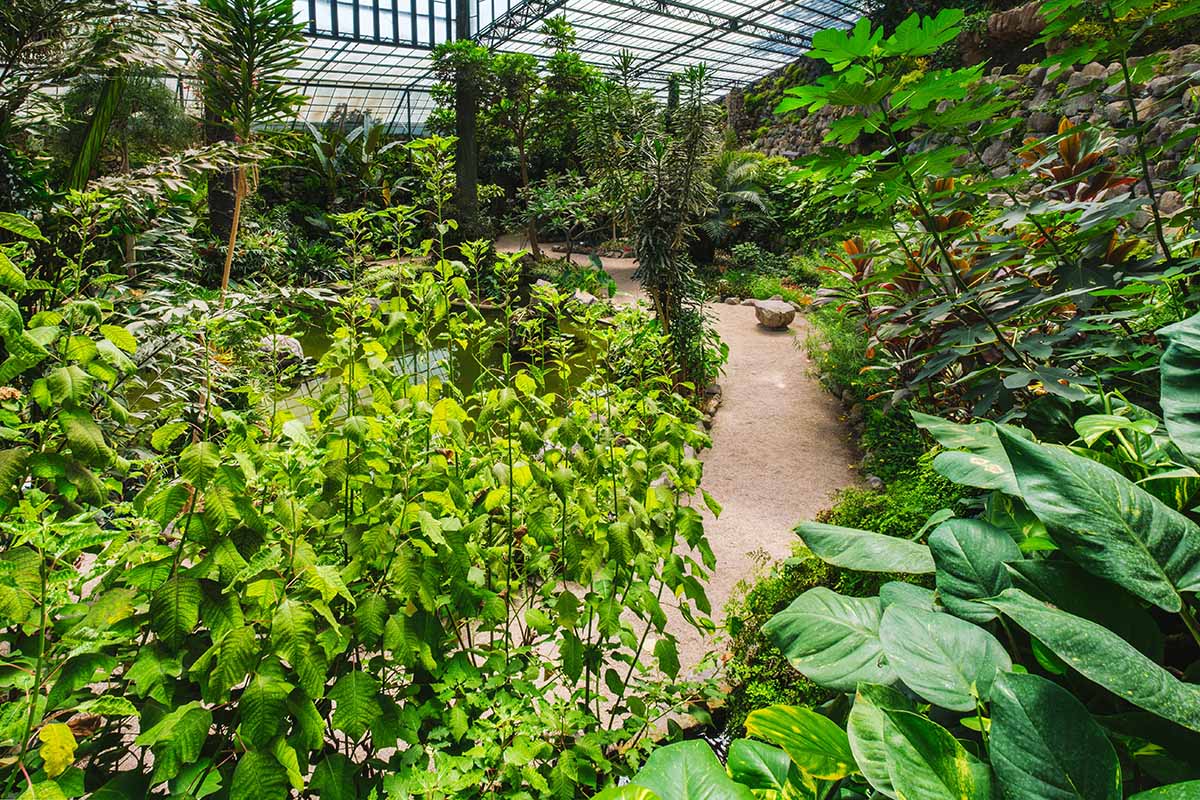The use of a greenhouse is undeniably the gold standard for extending the growing season.
Commercial growers could hardly survive without them, but just because they’re awesome, that doesn’t mean the traditional structure is the perfect design.
The modern greenhouse was invented in the 1800s in Holland. If you’ve ever been to Holland, then you know it has a moderate climate – not too cold in the winter and not too hot in the summer.
But we’ve adopted the design for use in regions with frigid winters and sweltering summers.

We link to vendors to help you find relevant products. If you buy from one of our links, we may earn a commission.
There are better solutions to the standard structure out there, believe it or not.
In the case of underground greenhouses, you get all the advantages of the traditional design with the added benefit of the earth’s insulation.
There are several types of underground greenhouses, and while they can be a step up (or down, as it were) from the traditional model, they do have some of their own unique challenges. We’ll go over all that and more in this guide.
Here’s what’s coming:
What You’ll Learn
Don’t pull out your shovel yet. Let’s start by talking about the different styles so you can choose which will suit your needs.
Types of Sunken Greenhouses
There are a few different types of pit or sunken greenhouses.
All of them use the sunken design to harness the insulating properties of the earth and passive solar to provide heat. Let’s start with the Chinese style.
Chinese
Chinese greenhouses are far superior to conventional types for those that live in cold regions.
These structures are slightly sunken below ground level by a foot or so, with the north side buried in a hillside.
You can achieve this by building the greenhouse into a hill or by building up earth on the north side, though modern designs are usually built as freestanding structures with brick or cement instead of earth.
The southern half of the roof and the southern, eastern, and western walls are sometimes made out of translucent material, though you will usually see the eastern and western walls at least partially constructed from earth, brick, or cement, as well.
This style of greenhouse is usually much shorter than a conventional structure, which means there is less area to keep warm. The thermal mass of the earthen wall helps retain heat, and the low amount of glass or plastic allows for less heat loss than with traditional greenhouses.
The orientation also allows for better heat absorption and maximizes light during the winter when the sun is low.
Traditionally, the structures are covered in insulating blankets at night to retain the heat, though not everyone does this today.

This concept has been adapted into what are called “Deep Winter Greenhouses,” which are structures with glazing on the south wall and the north wall built against a hillside or wall made out of brick or cement.
Pits
Pit structures, also called sun-pits or earth-sheltered greenhouses, are partially sunken into the ground with a small portion of translucent walls and a translucent ceiling.
Basically, they look like conventional greenhouses that have sunken into the ground a few feet. They still have the peaked or arched roofing and a door on the side.
The concept can be reduced down to cold frame size, with the cold frame partially sunken into the earth.
No matter the size, by replacing part of the glazing with earth, you increase the heat retention.
Walipini
The word “walipini” is the Aymara phrase for “place of warmth” and the design of this structure is built to retain as much heat as possible.
The primary difference between a pit style and a walipini – or underground – style is that walipini are sunken much deeper into the earth. They are usually about six to eight feet deep, with the roof being the only translucent part.
The roof is angled, not pitched, so that the pit receives maximum sunlight during the winter months and also allows for water runoff.

While we’re on the topic of light, the main disadvantage with this type of greenhouse is that it doesn’t work well in northern or southern latitudes.
It’s best for locations situated between the Tropic of Cancer and the Tropic of Capricorn. Those in more northern or southern areas will experience too extreme of an angle of sunlight in the winter for the light to reach the lower part of the pit.
They’re also a challenge to build because that’s a lot of digging to do. If you have an earth-mover, you’ll be better off, but it’s still a lot of work. This style is also better for dry areas than those that experience heavy rain, for reasons we’ll discuss in a bit.
Walipini greenhouses were invented in South America in 2002 when volunteers at the Benson Agriculture and Food Institute at Brigham Young University worked with locals in La Paz, Bolivia, to create a year-round growing space for farmers.
According to their study, the ground has a temperature of around 50°F when you dig down about four feet, so even when the aboveground conditions are well below freezing, the walipini could theoretically stay closer to 50°F.
The earth’s warmth, coupled with the sun’s rays entering the pit and being absorbed by the dark rock and soil of the structure, combine to produce significant heating effects.
The original structure was covered in a plastic sheet roof with a wall of rammed earth at the back and a floor made out of gravel and topsoil.
The design has been adopted by permaculturists and homesteaders, and has been adapted over time to include glass roofing, and some have a cut-out area at the lower, southern end to allow for a small portion of vertical glass. This allows low winter sunlight to penetrate the area, even in northern latitudes.
Advantages of Underground Greenhouses
The major advantage of a sunken-style structure is that the earth is an excellent insulator.
Imagine you’re in an unheated basement in the winter, and you touch the walls. They will probably be chilly but not freezing. If you touch a window, you’ll find it’s probably a lot colder.
It’s the same idea with earth and the glazing in a sunken greenhouse.
A conventional greenhouse is almost all glazing, which doesn’t hold heat well. At night, when the sun has set, the structure can lose a lot of its heat. That might work fine in Holland and parts of the United Kingdom, but it doesn’t cut it in North Dakota or Maine.
But a sunken structure can hold onto much more of the heat from the sun. That’s doubly true because earth is typically dark, and dark materials absorb and retain heat rather than reflecting it the way light materials do.
If you decide that you want to use additional heat in your greenhouse, maintaining the temperature is much easier, thanks to all that thick insulation.
We’re talking “citrus-fruits-in-the-depths-of-winter-in-North-Dakota” warm.
Then there’s the fact that the ground deeper down is warmer than that at the surface. Once you dig down four or five feet, the ground is consistently closer to 50°F in most areas.
Theoretically, sunken structures can be cheaper to construct than conventional ones because they require fewer materials. After all, a good portion of the wall is made out of existing dirt.
Having said that, if you live in an area with lots of moisture, you’re probably going to want to reinforce your structure with brick, rammed earth, or cement. If this is the case, the costs will rise significantly.
Disadvantages
Water is a significant concern with any sunken greenhouse.
Depending on the height of the water table, the presence of springs, and the amount of rainfall you receive, you could be facing serious water intrusion. And that’s assuming that the roof is watertight.
Excess water isn’t just an irritation in sunken structures, it can be a disaster. If water penetrates the walls, it could cause them to collapse.
Water coming up through the base can do the same, with the addition of causing rot in your plants and contributing to the spread of pathogens.
Walipini style greenhouses are often built into a hillside, where water damage can be catastrophic. We’re talking mudslides. For that reason, these are best reserved for dry climates that experience little rainfall.
The other major disadvantage is that the light is reduced unless you go with the Chinese style.
If you live in an extreme northern latitude, the sun is just so low in the winter that it’s unlikely to reach your plants if they are sunken any more than a foot or two underneath ground level.
Considerations
Even though you have less glazing to work with and your structure is partially insulated by the earth, you should still do your best to make your glazing as thick as possible so it traps the heat inside to minimize heat loss at night.
If you can’t afford double- or triple-layer glass or plastic, consider rolling thick mats over the glazing at night. In fact, if you live in Zones 5 or below, you might want to roll mats or blankets over the outside of the structure even if you have triple-layer glazing.

Situate your underground greenhouse so that it maximizes the amount of light it takes in. If you face the long side of your structure to the east, you’re losing out on a lot of light. Put the largest wall of glazing facing south (or north, if you’re in the Southern Hemisphere).
You should also make sure that there is nothing in front of the structure that will obstruct the sun, like a tree or a building. And remember, just because the sun has a direct line right now, that doesn’t mean it will in the winter when the sun is lower in the sky.
If you live somewhere with a very wet climate, consider building French drains on the outside of the structure to channel moisture away. A drainage ditch around the perimeter on the surface will also help divert rainfall.

The plants that you can grow in underground greenhouses are the same as those in conventional types. But since the pit structures usually retain more heat, you might be able to grow species you wouldn’t be able to otherwise.
If a conventional design raises the temperature by 10°F on average, you can expect to have an increase of 20°F or more, depending on the type of glazing you opt for and if you use insulating blankets at night.
Underground Greenhouses Are a Step Above Traditional Styles
Take your gardening game up a notch by taking a step (or two) down.
Underground greenhouses harness the power of the Earth to extend the growing season. They’ve been used for centuries to allow cultivation well into the winter months and beyond.

Which style are you considering? What will you grow in it? Let us know in the comments section below!
Still curious about greenhouse growing? We have several guides that can help expand your knowledge! Check out these next: